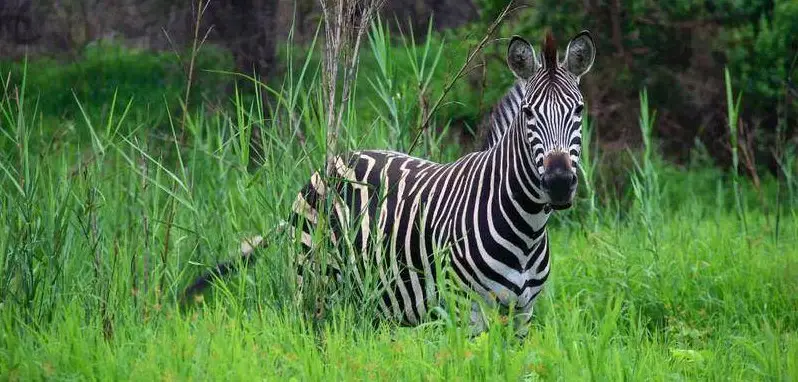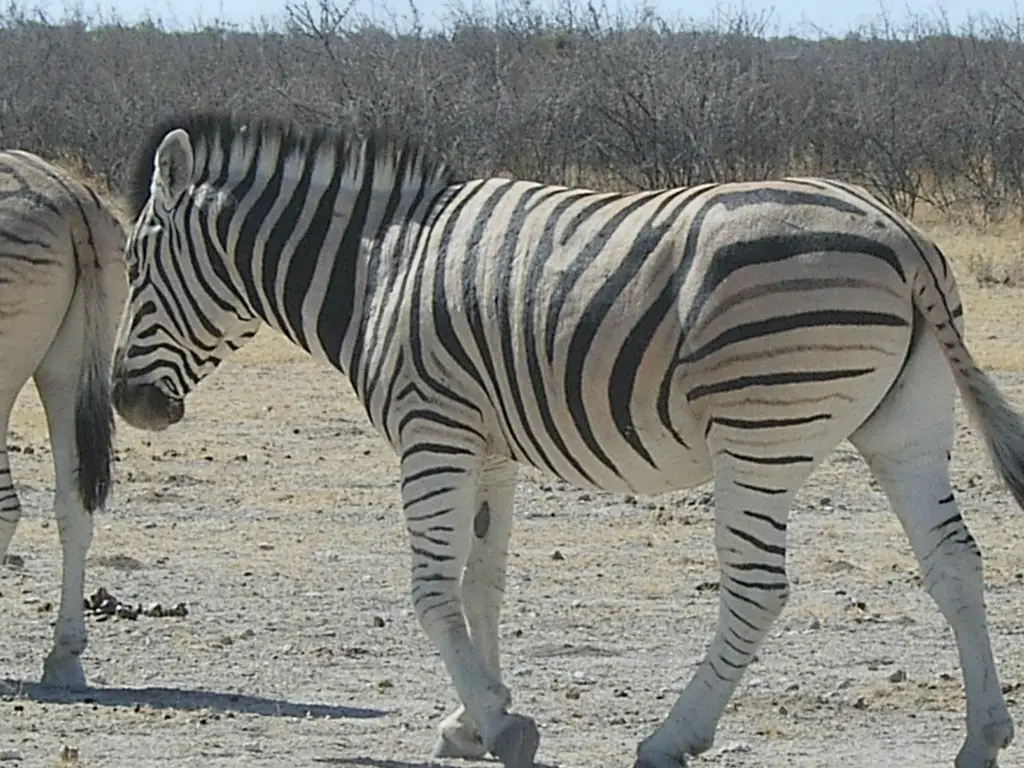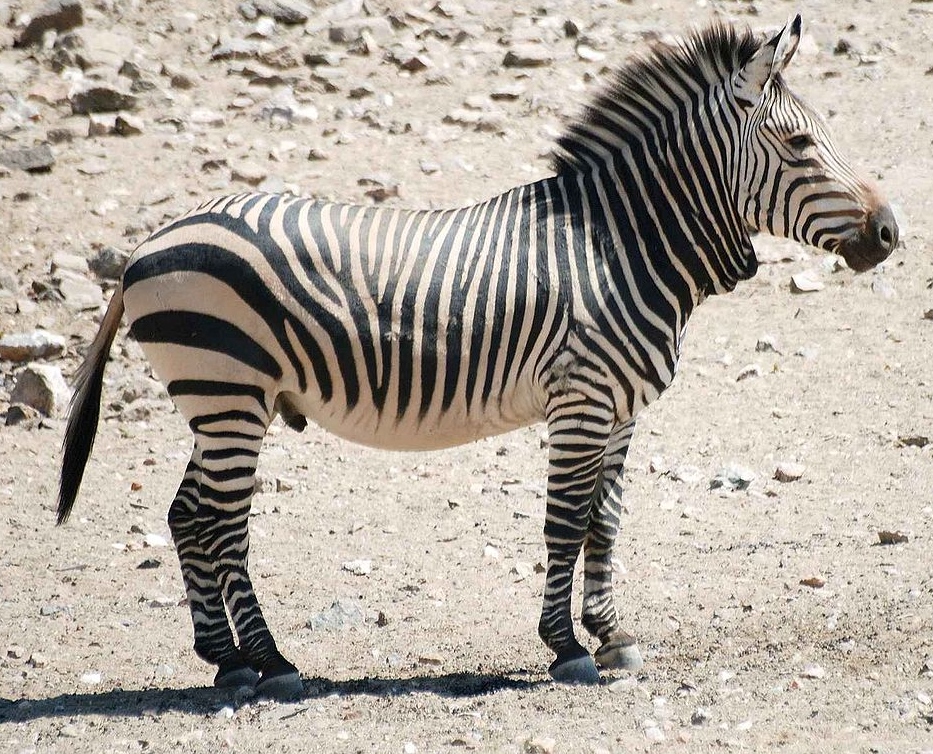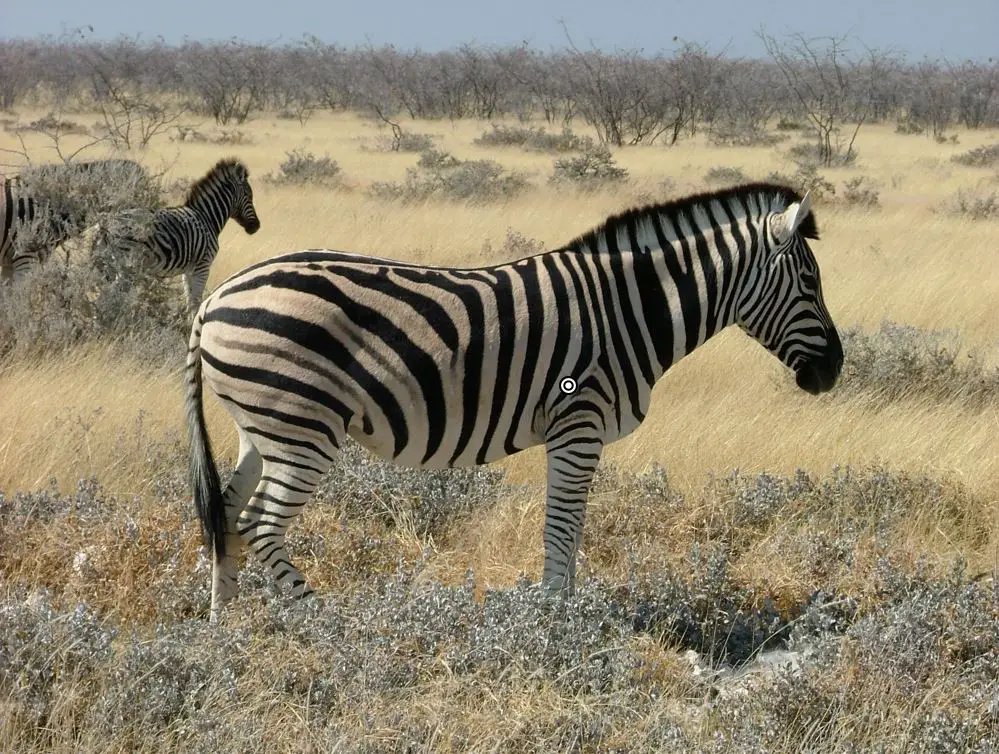When many people think about Africa, they often conjure visions of vast herds of Blue Wildebeest and zebra pursued by lion in the Serengeti Plains. This is for good reason: the zebra is one of the most widely distributed and easily recognized species on the entire continent. Though they are best known for their black and white stripes, there is much more to the zebras than their distinctive appearance.
Zebra Description & Distribution
Zebras, are a large species of equids that are found over most of eastern and southern Africa. There are two species that are sport hunted: the Plains Zebra (also known as the Common Zebra) and the Mountain Zebra, which is further divided into the Cape Mountain Zebra (in South Africa) and Hartmann’s Mountain Zebra (in Namibia) sub-species. Plains Zebra are the most widely distributed species are are found in South Sudan, Ethiopia, Uganda, Kenya, Tanzania, Zambia, Malawi, Mozambique, South Africa, Swaziland, Lesotho, Zimbabwe, Botswana, Namibia and Angola. A third species: Grévy’s Zebra, is present in small numbers in Kenya and Ethiopia, but is an endangered species and is not hunted.
Unsurprisingly, they are probably best known for their distinctive black and white stripes. Nobody is certain what the exact purpose of the stripes is. However, scientists have theorized that they act as a camouflage that makes it difficult for predators to spot or zero in on a particular zebra. Now black and white stripes may not seem like effective camouflage, but I can tell you from firsthand experience that they are much more difficult to spot in busy conditions that one would initially think.
Stripes are similar to fingerprints in that no two zebras have exactly the same pattern. However, they all have generally vertical stripes on their head, neck, and the front of their body that transition to horizontal stripes on their hindquarters. Zebras from each species and sub-species share the same characteristics, but there can be considerable variation of stripes between the differeAnt species and sub-species of zebra.
Generally speaking, mountain zebras have more narrow stripes and do not have “shadow” stripes while plains zebras have thicker stripes. Plains Zebras in southern Africa usually have “shadow” stripes, but the preponderance of shadow stripes is significantly less common in the more northern populations of Plains Zebra. Additionally, the stripes on Hartmann’s Mountain Zebras aren’t really white, they are more of an off white or light tan color.
A male Plains Zebra can reach a maximum height of just under 5 feet (1.5m) tall at the shoulder and weigh up to 850 pounds (385kg). Mountain Zebra are usually slightly smaller. Stallions (males) of both species are slightly larger than mares (females), though mares can still weigh as much as 760 pounds (345 kg). Besides the slight difference in size (and the presence of a penis) there are no other significant physical differences between mares and stallions. Over the years, many hunters have shot mares thinking they were stallions, or vice versa.
Plains Zebras are very social animals that congregate in family groups called “harems” of 5-10 animals (sometimes more) consisting of a dominant stallion, several mares, and their foals. Young stallions are ejected from the harem they were born in and typically live in bachelor groups until they are mature and strong enough to push an older stallion out of his harem.
Plains Zebra are grazing animals and are most often found in open grasslands. However, they will also live comfortably in moderately wooded areas and browse for their food if necessary. Though they do not normally live in swampy areas, Plains Zebras are dependent on a reliable water source and are rarely found far from water. They are known for making long migrations each year to areas with water as the seasons change.
Mountain Zebra live in much rougher terrain and typically have smaller harems than Plains Zebra as a result. They also prefer to eat grass, but will readily browse for their food if grass is in short supply. Like Plains Zebra, Mountain Zebra are also dependent on water. However, instead of migrating to find water, they will dig into riverbeds and old water holes to find it.
Since they have no horns, they are not “trophy hunted” in the same manner as most other species of plains game. Because of this, Safari Club International has no entries in their record book for zebras. Instead of horns, they are judged on the quality of their hide, since many hunters desire zebra rugs, or other trophies showing off their unusual colored hide. Zebras are preyed upon by a wide variety of animals including lion, hyena, leopard, cheetah, wild dogs and crocodile. Zebras also commonly bite and kick each other during fights for dominance. As a result, older animals, especially stallions, usually have hides with lots of “character” that demonstrate a history of close calls with predators and fights with other zebras (like the Mountain Zebra in the photo below). Some hunters want an old stallion bearing lots of scars, others want a younger one with a more pristine hide.
It’s all in the eye of the beholder.
Hunting Methods
Luckily, as long as there is a sizable population in the hunting area, hunting zebra is fairly straightforward, though not always easy. Probably the most common method is to attempt a stalk on a feeding herd of Zebra during the morning or evening when they are most active. However, if they are in open terrain, it may be difficult to approach them closely and this may result in a long range shot. Probably the easiest way to hunt zebra if it is legal in your chosen hunting area, and you consider it ethical, is by hunting over a water hole.
Another method I’ve used personally with great success, is to scout a number of water holes that zebra often frequent, find fresh tracks leading away from one, and follow the tracks. If food is available, zebra will often meander to and from drinking water at a slow pace, eating along the way. Zebra are also relatively noisy animals, so it is not difficult to find and approach them in moderate cover, as long as the wind is in your favor.
Recommended Cartridges
While they are not as tough as wildebeest, they are quite a bit bigger and must be treated with respect. A zebra shot with an underpowered cartridge or with a poor quality bullet can result in a very long day of tracking. Cartridges like the .270 Winchester, 280 Remington, .280 Ackley Improved, or 7mm Remington Magnum will work, but only with high quality bullets and perfect shot placement. The .308 Winchester and .30-06 Springfield, when using 180gr bullets, provide a more room for error and are superior choices in my opinion.
When hunting in thicker conditions where a short range shot is likely, such as many places in Zimbabwe, cartridges like the .450 Marlin, .444 Marlin, .45-70 Government, and .35 Whelen can be counted upon to deliver the bone crushing power necessary to ethically kill a big stallion. For those hunting in areas that may present some longer ranged shots (over 200 yards), such as Namibia or Tanzania, cartridges such as the .300 and .338 Winchester Magnums, or the 8mm Remington Magnum really come into their own and will deliver more than enough power at long range.
At the same time, there is absolutely nothing wrong with using a rifle chambered in 9.3x62mm,.375 H&H, .375 Ruger, or .458 Win Mag/.458 Lott on zebra, especially when hunting zebra as an add on to an elephant or buffalo hunt.
Make sure you wear ear protection though, particularly if you’re using a big magnum cartridge with a muzzle brake!
Zebra Shot Placement
A rule of thumb often used by zebra hunters is to aim at the center of the “Sergeant’s Chevron” on the animal’s shoulder. This shot placement will work, but hits a little too far forward for my taste. If the zebra is perfectly broadside, a shot through the chevron will go through the front of both lungs and maybe hit the heart as well. However, this shot leaves little room for error to the front. In my opinion, a shot just behind the chevron, as indicated below, is a much better choice. A shot placed there will hit the dead center of both lungs and the top of the heart with plenty of margin for error in all directions. If hit there with a powerful enough cartridge using a high quality bullet, the animal will not go far at all before expiring.
The zebra is a beautiful animal that provides a very unique trophy as well as a challenging hunt. Like the Blue Wildebeest, they are considered one of the cornerstones of a “classic” safari almost anywhere on the continent. No safari is complete without a zebra and I highly recommend adding one to your list if you’re planning a trip to Africa in the near future. Talk about a great gift for a hunter on your list!
Ready to go on an Africa hunting safari for zebra?
The Perfect Shot by Kevin Robertson was used as a reference for shot placement. I obtained the photo of the Hartmann’s Mountain Zebra from Wikimedia Commons
Make sure you follow The Big Game Hunting Blog on Facebook, Instagram, Twitter, and YouTube.
NEXT: READ THIS BEFORE HUNTING CAPE BUFFALO WITH THE .45-70 GOVERNMENT
John McAdams is a proficient blogger, experienced shooter, and long time hunter who has pursued big game in 8 different countries on 3 separate continents. John graduated from the United States Military Academy at West Point and is a veteran of combat tours with the US Army in Iraq & Afghanistan. In addition to founding and writing for The Big Game Hunting Blog, John has written for outdoor publications like Bear Hunting Magazine, The Texas State Rifle Association newsletter, Texas Wildlife Magazine, & Wide Open Spaces. Learn more about John here, read some of John’s most popular articles, and be sure to subscribe to his show: the Big Game Hunting Podcast.





